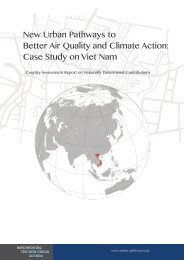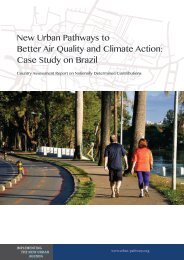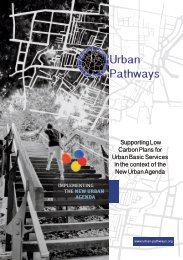Kenya
Create successful ePaper yourself
Turn your PDF publications into a flip-book with our unique Google optimized e-Paper software.
and hydro (IEA, 2014). At the moment only<br />
2.24 million people in <strong>Kenya</strong> have access<br />
to regular (grid based) power supply, most<br />
of which live in Nairobi. <strong>Kenya</strong> has two main<br />
energy suppliers, <strong>Kenya</strong> Power and KET-<br />
RACO. The government owns KETRACO<br />
entirely and owns 50.1% of <strong>Kenya</strong> Power.<br />
<strong>Kenya</strong> Power is also financed through commercial<br />
loans, paying annually 23 million<br />
USD in servicing debt.<br />
2.1.2 Transport<br />
<strong>Kenya</strong>´s main mode of transportation is<br />
road transport, accounting for 93% of<br />
freight and passenger traffic. The Agenda<br />
2030 has the goal to connect all regions of<br />
the country, primarily airports, railways and<br />
ports to enable economic activity. The north<br />
of the country is especially important as a<br />
connector to the neighbouring states, such<br />
as Democratic Republic of Congo, Rwanda,<br />
Burundi, Southern Sudan and Uganda.<br />
According to the ITF Transport Outlook<br />
2017, the infrastructure around centres, airports<br />
or production areas has to triple, to<br />
provide adeqate mobility (ITF, 2017). ITF<br />
predicts an increase in CO2 emission in<br />
Africa by 2050 from 2015 levels by almost<br />
three times, and <strong>Kenya</strong> has a key role in<br />
avoiding this increase.<br />
<strong>Kenya</strong>´s Vision 2030 foresees to promote<br />
mass transit systems to support the mobility<br />
of the high percentage of people who<br />
use non-motorised transportation. Shifting<br />
road freight to rail, water and non-moto<br />
rised transportation can reduce up to 4.1<br />
MtCO2 a year until 2030 (<strong>Kenya</strong>´s National<br />
Climate Change Action Plan, 2013). UNEP is<br />
working with the <strong>Kenya</strong>n government to implement<br />
a tax incentive scheme, increasing<br />
the share of cleaner vehicles, while banning<br />
old, emission intensive cars from <strong>Kenya</strong>´s<br />
roads (UNEP, 2014).<br />
3. <strong>Kenya</strong>´s Climate Change Action Plan<br />
The CC Action Plan will help delivering on<br />
several pressing issues in the country:<br />
Agriculture<br />
Agriculture is the largest GHG contributor<br />
in <strong>Kenya</strong> (30%), of which 90% come from<br />
Energy, trasport and<br />
resource management<br />
are identified as key<br />
climate change<br />
mitigation sectors.<br />
IMPLEMENTING<br />
THE NEW URBAN<br />
AGENDA<br />
www.urban-pathways.org








